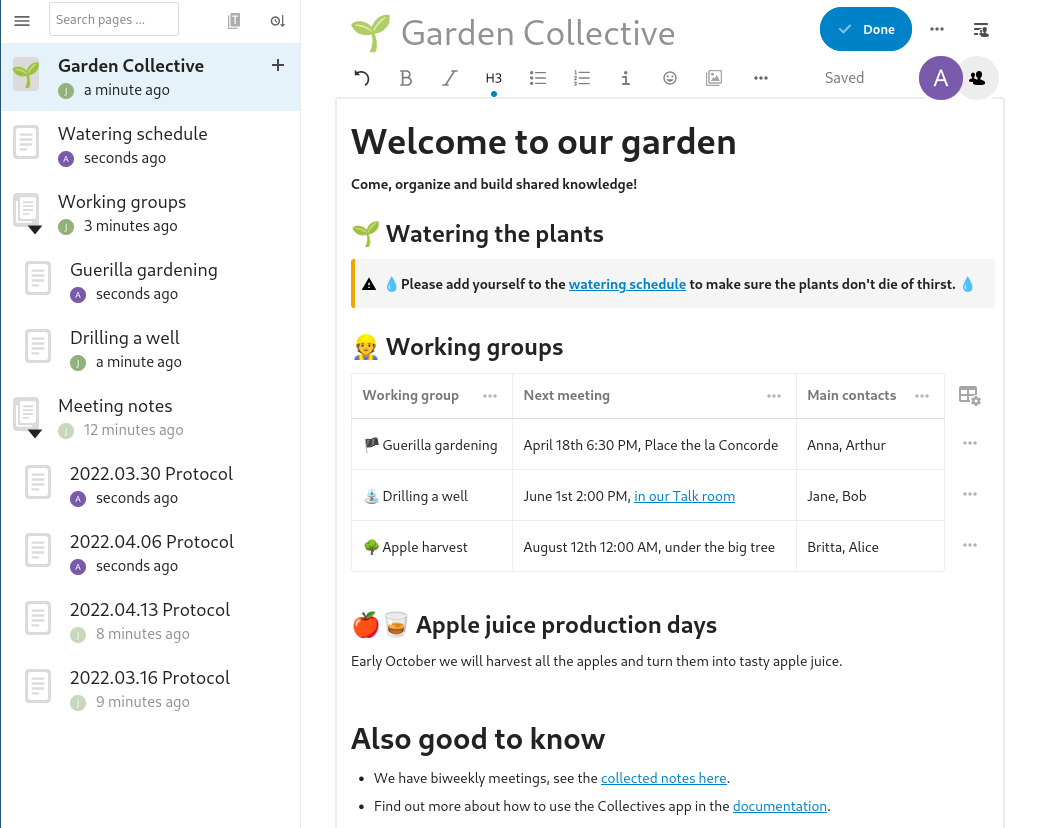Originally published at: All about Collectives: its founders, mission, and use cases. Create a Collective today! - Nextcloud


Max and Jonas are the innovators behind Collectives, a collaborative knowledge database or “Wiki” that is a growing, yet trustworthy space to share meeting notes, documents, and important information.
Collectives is the perfect app for thriving activist and community projects to come alive!
With Collectives, you have an entire page dedicated to your project, with the opportunity to organize all your information on a main page and in corresponding documents.
“Come, organize and build shared knowledge!”
The story of how it began
It’s true that many successful business ideas originate out of a need for something that is lacking. The same goes for Collectives, where innovators Max and Jonas recognized that the existing open source options to self-organize a community project were outdated and not intuitive. With a more modern user experience, they thought, more people would be open to working with such an app. With that in mind, the journey began!
With help in the form of funds and support from the German Federal Ministry of Education & Research (BMBF’s) Prototype Fund, they were able to work on the project full-time. The Prototype Fund is interested in community projects that benefit the public in tech and fund those with potential. Max and Jonas were even able to re-apply for funding and receive it, due to their need for maintenance and improvements in a new area.
Their goal and main focus has always been the same – create collaboration asynchronously that targets social groups that want to build their knowledge base.
This project that started with the Prototype Fund is what led the team to work at Nextcloud and continue their work on Collectives full-time.
To get an even more in-depth story of Collective’s roots and how the Prototype Fund works, feel free to listen to our podcast!
Use cases
The very first use case was started by founder Max, who used Collectives with his roommates to organize cleaning tasks and other coordination for their shared apartment. It was a great way to keep track of who bought what, appliances needing maintenance, and more.
Today, Collectives can be used for a variety of causes, that help organizations, individuals, and businesses stay organized, share information, and collaborate.
In an organization
An activist group running Café United, an independent and solidarity café for refugees to seek counseling in asylum and residency near Frankfurt, also uses Collectives.
Their team was driven to use Collectives due to its free and open source nature, as well as its simplicity and ability to collect many documents in one shared space.
Since they have a lot of contact with lawyers, translators, and NGO’s due to the nature of their service, it becomes very easy with Collectives to share these contacts and important information in a shared knowledge space. They also use it to upload meeting minutes and to have a place to develop and work together on ideas.
What I like best about Collectives is the clear design. I really like that I don’t have to click around that much to find what I am looking for.
Rosa from Café United
Personal Initiative
For one family, they use Collectives as a directory for their vacation home. Inside they have pages and sub pages they use internally within the family for coordination and preparation, as well as for guests. When they invite guests to stay there, they can export and/or print out a pdf that they give to the guests so that they have all the information they need regarding the home’s appliances, safety measures, and other protocols.
Business
Within Nextcloud GmbH, we use Collectives internally for our official company handbook. It’s a great space for management and HR to share important information and collaborate with employees.
Overall, Collectives has the potential to make a mark in your organization, personal initiative, or business.
Coming soon to your Collective
Max and Jonas both share a passion to continue Collective’s progress and success.
With the new Nextcloud 24 release, for example, comes exciting new editable sharing and permission management. The admin of the Collective can now allow whoever he or she wants to edit documents. Also what’s new is the ability to create beautiful tables within Collective pages, and being able to set a default order to pages like “most recent.”
Other ideas in the making are “Collectives” to have the ability to add attachments to pages, an improved search bar, custom page order, and more! Stay tuned for when these updates come out!
The team of two also hopes to start doing coordinated user testing at a local university, amongst family and friends, and through a focus group. This way, they could see first-hand how others approach Collectives, learn how to use it, and navigate through the app. From a developer’s perspective, this kind of data provides clarity and can be extremely helpful in making new improvements and features. In fact, you can already contribute now to an important survey here!
What we love about Collectives
Here’s the top features in Collectives right now:
- A Collective is owned by a Nextcloud Circle – Circles are special groups with other users, colleagues, and friends that can be used with other apps for sharing purposes through an API.
- Collaborative page editing
- Popular Markdown language usage
Markdown is a well-know, easy to use favorite for simple page formatting. Whether you want to make simple headings, bolded sections, or bullet points, it’s easy for everyone to use.
Try it out yourself
Truly the best way to get to know this innovative collaborative knowledge database is to try it out yourself.
Simply go to the Nextcloud App Store and find the Collectives app!
On behalf of the Nextcloud Collective’s team, we wish you success in your Collective, making it work for your goals and initiatives.